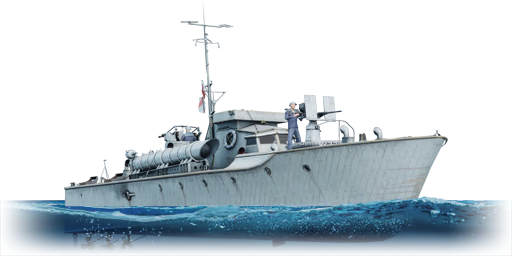



The Vosper 73ft Motor Torpedo Boat was a class of 29 MTBs produced for the Royal Navy. It was designed in 1943 as a replacement for the early 70ft Vosper MTB. Compared to its predecessor, the 73ft class featured improvements that would make it more suitable for combating enemy torpedo boats, a role typically designated for the Motor Gun Boat (MGB). To achieve this, the 73ft featured a single 20 mm Oerlikon autocannon at the bow and two 12.7 mm Vickers MGs at the stern. After entering service in 1944, the 73ft Vospers saw service alongside its predecessor and were decommissioned in the mid-1950s.
Introduced in Update 1.83 "Masters of the Sea", "MTB Vosper(2)" is a noticeable improvement over its predecessor, featuring a more capable Oerlikon autocannon to deal with enemies, while retaining the overall good mobility. However, much like its predecessor, the Vosper’s wooden hull is not able to endure much damage.
| Belt | Belt filling | Armor penetration (mm) at a distance: | |||||
|---|---|---|---|---|---|---|---|
| 10 m | 100 m | 500 m | 1000 m | 1500 m | 2000 m | ||
| HEF-T/HEF-I/AP-T | 34 | 32 | 26 | 21 | 18 | 16 | |
| AP-T/AP-T/AP-T/HEF-I | 34 | 32 | 26 | 21 | 18 | 16 | |
| HEF-T/HEF-I/AP-T/HEF-I | 34 | 32 | 26 | 21 | 18 | 16 | |
| Belt | Belt filling | Armor penetration (mm) at a distance: | |||||
|---|---|---|---|---|---|---|---|
| 10 m | 100 m | 500 m | 1000 m | 1500 m | 2000 m | ||
| T/AP/HEI | 24 | 24 | 21 | 18 | 16 | 15 | |
| T/HEI/HEI/HEI | 20 | 19 | 16 | 14 | 12 | 11 | |
| T/AP/HEI/AP | 24 | 24 | 21 | 18 | 16 | 15 | |
4 × Mk.VII depth charge











Seakeeping |
|---|
Unsinkability | |
|---|---|
Firepower | ||
|---|---|---|